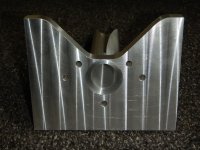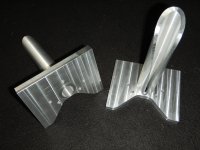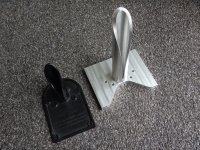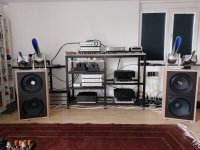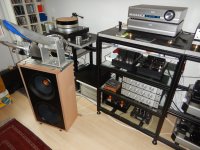Not sure as I view it as an octave spread: ln(2155.5/141.4)/ln(2) = ~3.93That would work out to be roughly at the 1/3 length of the tube right?
What about multiple small braces so it is almost like a grill? If a larger pipe (3"x30") that isn't playing the top two octaves aren't the waves too long to see a few 1/4" braces? Or will they themselves cause diffraction?
ln(2155.5/551.4)/ln(2) = ~1.97 octave spread
3.93/1.97 = 1.99, so 1/2 as a starting point, which with a closed cylinder puts it on a F3 pressure node and once found, probably won't need but one brace.
In short, try ~1/3 and/or 1/2 to if not actually measuring it as to which comes closest with the understanding that the flare will probably shift it quite a bit.
As for messing with holes, etc., best to follow muffle design.
So are you saying that there is one main location that originates the vibration?Interesting. I will see if I can actually observe a node in my big pipe.3.93/1.97 = 1.99, so 1/2 as a starting point, which with a closed cylinder puts it on a F3 pressure node and once found, probably won't need but one brace.
One thing I tried with my experiment to find resonances in the transylvania tube was to try to reduce the ringing I observed by adding a screw, which is slightly longer than the width of the tube, at the end of the tube - this stretched the tube slightly open and the stress applied which opens the tube should reduce these spring resonances. I did this before and after I did the knuckle rap test and I observed ringing either way. I could repeat the experiment some more as when I did this experiment the screw was placed at the end of the tube, while placing the internal "brace" more towards the middle of the tube, and maybe adding multiple braces, which would be more effective.
The idea of making the tube thicker closest to the tube slot would seem to help a lot, as it would seem that the pressure wave leaving the slot would apply the greatest stress on the tube at that point. However, if the tube by the slot is stiff and well damped, then the weaker, opposite side of the tube would continue to flex. If we want to reduce resonances as much as possible, and are not concerned about weight, then just make the entire tube thicker, or better damped, or both. Making the tube thicker at the slot would allow you to create a roundover at that point, reducing the resonances created as the sound wave exits from the high pressure to low pressure environment. So not only is the tube itself resonating, the pressure wave itself is resonating due to the design of the tube.
I think that using multiple materials, which resonate/flex at different frequencies, or can damp resonances, can be one means to reduce these resonances. Reinout used the two materials and thought that it was effective to reduce the resonances. Maybe we should ask him what he observed when he used the two materials for his tubes.
Retsel
The idea of making the tube thicker closest to the tube slot would seem to help a lot, as it would seem that the pressure wave leaving the slot would apply the greatest stress on the tube at that point. However, if the tube by the slot is stiff and well damped, then the weaker, opposite side of the tube would continue to flex. If we want to reduce resonances as much as possible, and are not concerned about weight, then just make the entire tube thicker, or better damped, or both. Making the tube thicker at the slot would allow you to create a roundover at that point, reducing the resonances created as the sound wave exits from the high pressure to low pressure environment. So not only is the tube itself resonating, the pressure wave itself is resonating due to the design of the tube.
I think that using multiple materials, which resonate/flex at different frequencies, or can damp resonances, can be one means to reduce these resonances. Reinout used the two materials and thought that it was effective to reduce the resonances. Maybe we should ask him what he observed when he used the two materials for his tubes.
Retsel
I lack the physics knowledge to judge the effect of a thicker tube (deeper slot). If a thicker wall with roundover works well I would make something like this:If we want to reduce resonances as much as possible, and are not concerned about weight, then just make the entire tube thicker, or better damped, or both. Making the tube thicker at the slot would allow you to create a roundover at that point, reducing the resonances created as the sound wave exits from the high pressure to low pressure environment. So not only is the tube itself resonating, the pressure wave itself is resonating due to the design of the tube.
The wood bracing beam in the back halves the cantilever arch distance by half so should also be very effective.
The most elegant solution would be this:
But that would be harder to produce.
Last edited:
UPDATE:
I received the 2.5" monster compression driver and was very disappointed. It has many weird and very loud resonances from 100-600hz. Makes the driver totally unusable. Only above 600hz does it get better. So I am returning it.
I received the 2.5" monster compression driver and was very disappointed. It has many weird and very loud resonances from 100-600hz. Makes the driver totally unusable. Only above 600hz does it get better. So I am returning it.
Too bad about that compression driver.
In my case, I had purchased B&C DCM420 compression drivers to try out. There is a frequency sweep available on B&C's website so I could see that the frequency response is smooth (as expected as a ring radiator), although not flat. Because B&C measured the frequency response on an exponential horn, I expected the frequency response to be pretty tipped up on these transylvania tubes, and it is, but I am finding out that it will take some doing to get a good acceptably flat frequency response. - I still have a couple peaks. I am still working on it...
I did try some more experiments to see if I could dampen the resonances of these PVC tubes. For my first attempt, added a screw at the very end of the tube (furthest away from the driver) which pries the tube open horizontally, thinking that the stress would dampen some of vibrations of the tube. The knuckle rap test showed that this did not seem to help much.
For the second experiment I kept the screw at the end of the tube, but added a small piece of metal which pries open the slot about 40% down the tube from the driver. The two braces did make a difference with the knuckle rap test. Not only does my phone ap show less sound output from the rapping, knocking on the tube reveals that the tube seems stiffer, although not nearly as stiff as rapping on a 2 inch PVC tube with no slot cut into it. This tweak, however, did not impact that frequency peak I have at 1 k hz.
Retsel
In my case, I had purchased B&C DCM420 compression drivers to try out. There is a frequency sweep available on B&C's website so I could see that the frequency response is smooth (as expected as a ring radiator), although not flat. Because B&C measured the frequency response on an exponential horn, I expected the frequency response to be pretty tipped up on these transylvania tubes, and it is, but I am finding out that it will take some doing to get a good acceptably flat frequency response. - I still have a couple peaks. I am still working on it...
I did try some more experiments to see if I could dampen the resonances of these PVC tubes. For my first attempt, added a screw at the very end of the tube (furthest away from the driver) which pries the tube open horizontally, thinking that the stress would dampen some of vibrations of the tube. The knuckle rap test showed that this did not seem to help much.
For the second experiment I kept the screw at the end of the tube, but added a small piece of metal which pries open the slot about 40% down the tube from the driver. The two braces did make a difference with the knuckle rap test. Not only does my phone ap show less sound output from the rapping, knocking on the tube reveals that the tube seems stiffer, although not nearly as stiff as rapping on a 2 inch PVC tube with no slot cut into it. This tweak, however, did not impact that frequency peak I have at 1 k hz.
Retsel
Good evening Erik and Retsel,
both options work (multi-layer or changing wall thickness); as long AS you take tube-resonance into consideration you're good to go.
The original K-tube was not bad as it has some inheritant anti-resonance features because of the production proces (= casting !):
I did numerous resonance tests and finally used 2 versions to get the k-tube under control:
(excuse my lousy English)
Regards,
Reinout
Mid november i'll join the ETF (European Triode Festival and i'm planning to bring along the active 4 way speaker system (bas+bos/mid open bafle; mid and high by compression drivers + K-tubes. ALL drivers fieldcoils.). Will be interesting. Pictures of the speakers enclosed
both options work (multi-layer or changing wall thickness); as long AS you take tube-resonance into consideration you're good to go.
The original K-tube was not bad as it has some inheritant anti-resonance features because of the production proces (= casting !):
- the tube had the most minute tapering in order to get the innards clean of the casting-form. This 2 degree angle makes it more difficult for standing waves (= resonance) to travel thru the object.
- there are some mechanical supports next to the base-plate in order to make the tube more rigid to that base-plate. Perfect resonance control !
I did numerous resonance tests and finally used 2 versions to get the k-tube under control:
- for a small tube a use the most technical "advanced" version: different wall thickness ! An incredible old-fashioned but very effective way to supress resonances. I've made the wall thickness at the slot-side the most thin and at the spine the most "thick". Vice versa I do not promote as your radiation pattern will be influenced by that thick transition from solid-to-air. Pictures included. And it is just like Erik's draft.
- for a big tube the above mentioned system is not the way to go for price reasons and logic. You need a 5 axis CNC machine which must be capable of an exentric hole (ok....), an exponential slot with the sides perpendicular to the axis (ok for a certain price), a 2 degree tapering (slowly but surely the price shall rise...) and that with Erik's ratio 1:10 shall need a CNC-range of 20" for a 2 " driver.......for my that is impossible so i settled for the next best option: combination of layers: a metal and a plastic being the logical combo. You're spoilt by choice.....
(excuse my lousy English)
Regards,
Reinout
Mid november i'll join the ETF (European Triode Festival and i'm planning to bring along the active 4 way speaker system (bas+bos/mid open bafle; mid and high by compression drivers + K-tubes. ALL drivers fieldcoils.). Will be interesting. Pictures of the speakers enclosed
Attachments
Thanks Reinhout for your response. It would make sense that different materials, and/or variations in wall thickness, would help in dampening the resonances caused by vibrations in the tubes. Were you able to make any measurements which could document this effectiveness, before and after?
You seem to conclude that the tube vibrations are the only resonances to be concerned with. However, it is well established that abrupt changes in physical surfaces also cause resonances, creating Higher Output Modes (HOMs). The abrupt change in physical boundary (the edge of the slot) will cause a reflection backward towards the sound source, in case of the tube, either to the back side of the tube - opposite of the slot, or all the way back to the driver. Compared to horns, the transylvania tubes have an advantage by having the discontinuity at different distances from the cone, thus, instead of creating such resonances at a single frequency - created at the mouth of the horn - the tube spreads the resonances over the whole range of frequencies. While that would help to reduce the prominence of the resonances, they are still there. If we want to make a better tube, so to speak, we would want to change the design of the tube to prevent these resonances. We know from experiments with horns that a large roundover at the horn mouth prevents these resonances from occurring (the Le Cleac'h horns) smoothing the frequency response. Earl Geddes accomplishes a partial fix by adding open cell foam in the horn throat which helps to attenuate these resonances It may be worth trying this for these tubes. However, another potential fix would be to make the tube wall very thick at the slot, avoiding creating the resonances in the first place. You and Erik seem to discount this option but this would fix both the tube vibrations and the edge discontinuities.
One other source of a resonance is the discontinuity where the tube mates with the compression driver. Compression drivers usually have a fixed exit angle, which is not 90 degrees, and to avoid creating resonances at this point, the tube must be expanding at the same rate as that inside the compression driver: https://www.diyaudio.com/community/...s-to-compression-drivers-a-discussion.397699/
While it could be argued that the tube slot spreads out the resonances over many frequencies caused by the slot, any mismatch of the tube entrance angle to the compression driver exit angle will create a resonance at one specific frequency. I e-mailed B&C to find out what the exit angle is of the DCM420 drivers which I am using, but I did not receive a response. Once I find this out, I will need to figure out a way to account for that.
Retsel
You seem to conclude that the tube vibrations are the only resonances to be concerned with. However, it is well established that abrupt changes in physical surfaces also cause resonances, creating Higher Output Modes (HOMs). The abrupt change in physical boundary (the edge of the slot) will cause a reflection backward towards the sound source, in case of the tube, either to the back side of the tube - opposite of the slot, or all the way back to the driver. Compared to horns, the transylvania tubes have an advantage by having the discontinuity at different distances from the cone, thus, instead of creating such resonances at a single frequency - created at the mouth of the horn - the tube spreads the resonances over the whole range of frequencies. While that would help to reduce the prominence of the resonances, they are still there. If we want to make a better tube, so to speak, we would want to change the design of the tube to prevent these resonances. We know from experiments with horns that a large roundover at the horn mouth prevents these resonances from occurring (the Le Cleac'h horns) smoothing the frequency response. Earl Geddes accomplishes a partial fix by adding open cell foam in the horn throat which helps to attenuate these resonances It may be worth trying this for these tubes. However, another potential fix would be to make the tube wall very thick at the slot, avoiding creating the resonances in the first place. You and Erik seem to discount this option but this would fix both the tube vibrations and the edge discontinuities.
One other source of a resonance is the discontinuity where the tube mates with the compression driver. Compression drivers usually have a fixed exit angle, which is not 90 degrees, and to avoid creating resonances at this point, the tube must be expanding at the same rate as that inside the compression driver: https://www.diyaudio.com/community/...s-to-compression-drivers-a-discussion.397699/
While it could be argued that the tube slot spreads out the resonances over many frequencies caused by the slot, any mismatch of the tube entrance angle to the compression driver exit angle will create a resonance at one specific frequency. I e-mailed B&C to find out what the exit angle is of the DCM420 drivers which I am using, but I did not receive a response. Once I find this out, I will need to figure out a way to account for that.
Retsel
I am not discounting any possibility. I just don't have the knowledge to judge one way or the other. My gut instinct tells me you want the wall thickness at the slot thin but I am aware this gut feeling could be wrong.However, another potential fix would be to make the tube wall very thick at the slot, avoiding creating the resonances in the first place. You and Erik seem to discount this option but this would fix both the tube vibrations and the edge discontinuities.
Yes, I was also looking at this. Ideal would be a gradual transition to straight or even removing the screen and inserting the tube into the driver exit to eliminate any flair.One other source of a resonance is the discontinuity where the tube mates with the compression driver.
You can stick a thin sewing needle through the screen and slide it along the wall on the inside. You can then measure the angle. Not super precise but close enough to work with in my opinion.I e-mailed B&C to find out what the exit angle is of the DCM420 drivers which I am using, but I did not receive a response. Once I find this out, I will need to figure out a way to account for that.
FWIW, I removed all Altec, etc., screens except for when needing its protection and while I could only hear a slight difference in tonal balance, the women noticed a better performance overall in the precious few ~full range recordings I still have and now long gone RTR system/tapes that were standouts.
After living with the midrange Transylvania tubes for a while, I went back to the Lowthers in front waveguides as the sound from the midrange Transylvania tubes had too many resonances - sounded like fingernails on a chalkboard to me. Then after a number of weeks with the Lowthers and playing around with X-Sim for a revised crossover for the midrange Transylvania tubes, I decided to give them another shot.
The revised crossover for the midrange Transylvania tubes improved the frequency response, but I still ended up with a peak at 3 khz. I designed a trap for that 3k problem with x-Sim, however, before spending the time and money purchasing new passive crossover components for that trap, I spent some time listening to the midrange Transylvania tubes with a revised crossover to gain a better sense of what this type of midrange speaker ultimately provides, It took some time, but I was able to identify a key quality of this speaker.
One important quality of the midrange Transylvania tube is that the treble is very dynamic, while the midrange is not so dynamic. This can be explained because the tube is in essence a horn with a very small mouth, thus, the high frequencies are directed forward at a high SPL, while the midrange is omnidirectional at a much lower sound pressure level. Since horns push the soundstage forward this explains why the treble is more in your face, while the midrange is more distant. Standing to the side of the midrange Transylvania tubes the sound is fully omnidrectional below 1000 hz and increasingly directional about 1000 hz. If I was crossing over to an omnidirectional woofer, this might be OK since the transition to the omni woofer would be consistent, but the Karlson K15 bass is more like a horn, with the soundstage pushed forward, so the midrange Transylvania tube midrange is out of sorts with the rest of the soundstage of my audio system. I have concluded that the midrange Transylvania tube does not work for me. Reinout uses a less forward angle for his Transylvania tubes and this could be to make the upper frequencies of his tubes more omnidirectional, consistent with the lower frequencies of each tube.
If the Transylvania tube did not have that soundstage issue, for me to be satisfied with this speaker concept I would still need to fix the tube resonances issue caused by the tube itself and the discontinuity of the difference in exit angle of the compression driver and the beginning of the Transylvania tube, as well as the discontinuity all along the exit of the Transylvania tube (the mouth). But on top of all that, you are throwing away a lot of midrange efficiency and dynamics by going with his Transylvania tube over a horn.
The experiment with the Transylvania tube has helped to illustrate an issue I have with my waveguided Lowther system. I use flimsy cardboard panels to form the waveguides for the Lowthers, and while the carboard is inherently resonance free, it is flimsy, and this softens the dynamics of the sound. As I always intended, I will need to create or purchase a decent set of horns/waveguides, which I intended to do once I finished my room.
I am also interested in playing around with these 2 inch B&C compression drivers some more. When designing a horn/waveguide for the Lowthers, I will try to make an adapter so that the compression drives would also work with the horns/waveguides and compare the two.
Retsel
The revised crossover for the midrange Transylvania tubes improved the frequency response, but I still ended up with a peak at 3 khz. I designed a trap for that 3k problem with x-Sim, however, before spending the time and money purchasing new passive crossover components for that trap, I spent some time listening to the midrange Transylvania tubes with a revised crossover to gain a better sense of what this type of midrange speaker ultimately provides, It took some time, but I was able to identify a key quality of this speaker.
One important quality of the midrange Transylvania tube is that the treble is very dynamic, while the midrange is not so dynamic. This can be explained because the tube is in essence a horn with a very small mouth, thus, the high frequencies are directed forward at a high SPL, while the midrange is omnidirectional at a much lower sound pressure level. Since horns push the soundstage forward this explains why the treble is more in your face, while the midrange is more distant. Standing to the side of the midrange Transylvania tubes the sound is fully omnidrectional below 1000 hz and increasingly directional about 1000 hz. If I was crossing over to an omnidirectional woofer, this might be OK since the transition to the omni woofer would be consistent, but the Karlson K15 bass is more like a horn, with the soundstage pushed forward, so the midrange Transylvania tube midrange is out of sorts with the rest of the soundstage of my audio system. I have concluded that the midrange Transylvania tube does not work for me. Reinout uses a less forward angle for his Transylvania tubes and this could be to make the upper frequencies of his tubes more omnidirectional, consistent with the lower frequencies of each tube.
If the Transylvania tube did not have that soundstage issue, for me to be satisfied with this speaker concept I would still need to fix the tube resonances issue caused by the tube itself and the discontinuity of the difference in exit angle of the compression driver and the beginning of the Transylvania tube, as well as the discontinuity all along the exit of the Transylvania tube (the mouth). But on top of all that, you are throwing away a lot of midrange efficiency and dynamics by going with his Transylvania tube over a horn.
The experiment with the Transylvania tube has helped to illustrate an issue I have with my waveguided Lowther system. I use flimsy cardboard panels to form the waveguides for the Lowthers, and while the carboard is inherently resonance free, it is flimsy, and this softens the dynamics of the sound. As I always intended, I will need to create or purchase a decent set of horns/waveguides, which I intended to do once I finished my room.
I am also interested in playing around with these 2 inch B&C compression drivers some more. When designing a horn/waveguide for the Lowthers, I will try to make an adapter so that the compression drives would also work with the horns/waveguides and compare the two.
Retsel
I would love to get a pair of these compression drivers where to get them from if you don't mind sharingReally have been enjoying the sound of my 1.5" PVC k pipe. Very crisp/immediate/realistic without any coloration.
The 2.5" pipe with weak motor fr driver sounds promising but most definitely cannot keep up with the hf compression driver. SO NOW I FOUND THIS:
View attachment 1366403
A 2.5" exit, 650W, 88.9mm voice coil compression driver. I really don't know a thing about these monster long throw outdoor public address drivers but I would like to try. I have a bunch of bills to pay soon......if I have some money left over I may get one just for the heck of it. I can get one for around 90 bucks. I guess the only country where you could get these cheaper is North Korea. I like the look of that diaphragm. Looks like a ring radiator with total diaphragm diameter of almost 15 cm.... that's insane!
View attachment 1366409
I can see a project with a Klipsch Heritage bass horn with a 2.5"/70cm k pipe doing 300-3000hz and a 1"/23cm k pipe with 18sound nd1tp compression driver doing 3000hz and up
As Eric wrote in post #9, Standard Audio Co. LTD "This being Thailand the manufacturer link is not working."I would love to get a pair of these compression drivers where to get them from if you don't mind sharing
Might find out more on Facebook:
standard audio co.,ltd
https://www.facebook.com/0869860760SA/That said, why would you want it?I received the 2.5" monster compression driver and was very disappointed. It has many weird and very loud resonances from 100-600hz. Makes the driver totally unusable. Only above 600hz does it get better. So I am returning it.
- Home
- Loudspeakers
- Multi-Way
- Large Karlson tube midrange smoothing
